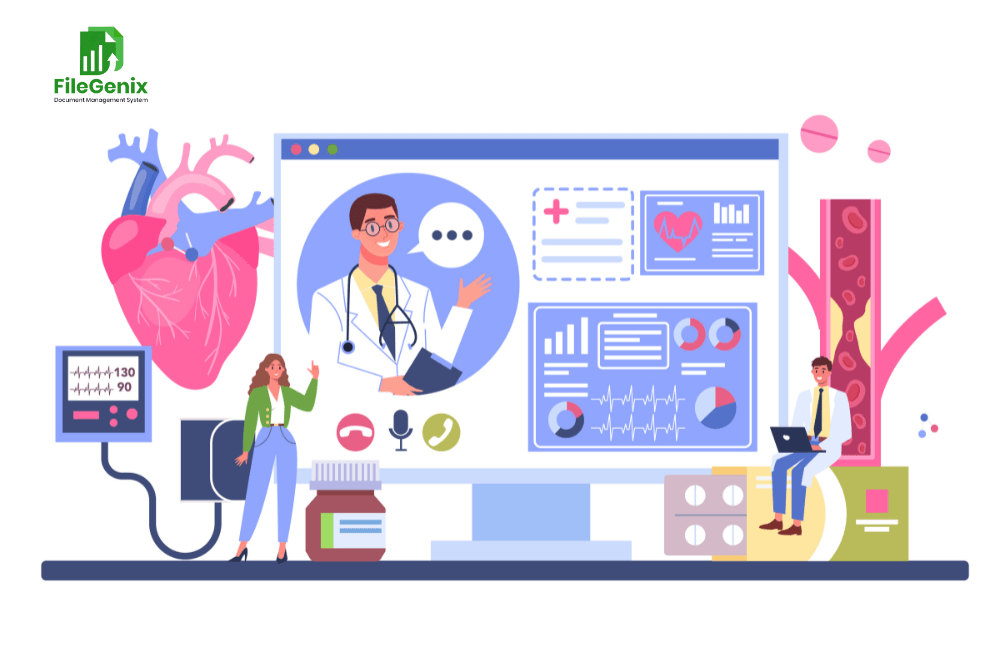Did you know that healthcare data breaches cost an average of $10.93 million per incident—higher than any other industry? (IBM Cost of a Data Breach Report, 2023). In 2023 alone, more than 133 million healthcare records were exposed to cyberattacks (U.S. Department of Health and Human Services, 2023).
With numbers like these, it’s no surprise that many healthcare professionals worry about the security of Electronic Health Records (EHRs). But here’s the problem: there are a lot of misconceptions about EHR security, and believing the wrong ones can leave patient data at risk.
In this article, we’ll reveal four major myths about EHR security and show you what actually keeps your patient records safe.
Myth #1: EHRs Are More Vulnerable to Hacking Than Paper Records
Many healthcare providers assume that keeping records on paper is safer because it avoids digital cyberattacks. But the reality? Paper records are far easier to steal, lose, or destroy.
- Physical theft is a major issue – A lost or stolen paper file can never be recovered, while digital records are encrypted and backed up.
- Natural disasters destroy paper records – Fires, floods, or even accidental spills can wipe out physical documents permanently.
- Lack of access controls – Unlike digital records, paper files don’t have login protections or role-based access. Anyone who finds a patient’s chart can read it.
The Truth:
Modern EHR systems use encryption, authentication protocols, and access controls to protect data better than paper ever could. A lost laptop with encrypted data is useless to hackers, while a stolen paper record is immediately readable.
🔍 Stat to Note: 74% of healthcare breaches involve internal negligence, lost devices, or paper record theft rather than external cyberattacks (Verizon Data Breach Investigations Report, 2023).
Myth #2: Only Large Hospitals Need Strong EHR Security
It’s easy to think that cybercriminals only target big hospitals with massive amounts of data. But in reality, small and mid-sized clinics are prime targets for attacks because they often have weaker security measures.
- Smaller clinics typically lack IT teams and don’t invest in advanced security tools.
- Hackers go after low-hanging fruit – A large hospital may have advanced cybersecurity, but a small clinic with weak defenses is an easier target.
- Ransomware doesn’t discriminate – Many attacks are automated and hit any system with vulnerabilities.
The Truth:
Even a single breached patient record can lead to HIPAA violations, legal action, and loss of trust. Every healthcare provider, big or small, needs robust EHR security.
🔍 Stat to Note: 60% of small healthcare organizations shut down within six months of a cyberattack due to financial losses and reputational damage (National Cyber Security Alliance, 2023).
Myth #3: Compliance with HIPAA Means You’re 100% Safe
Many healthcare organizations think that following HIPAA rules is enough to prevent security breaches. While HIPAA is essential, it only sets a baseline—it doesn’t guarantee complete protection.
- HIPAA compliance doesn’t prevent new cyber threats.
The law was designed in 1996, long before modern ransomware and AI-driven cyberattacks. - Compliance is not the same as security.
HIPAA ensures patient privacy, but it doesn’t cover advanced cybersecurity measures like AI threat detection or real-time monitoring. - Many compliant organizations still get hacked.
Even if a hospital follows all HIPAA rules, it can still suffer a phishing attack or insider threat.
The Truth:
Being HIPAA-compliant is just the starting point. Healthcare providers need ongoing cybersecurity training, penetration testing, and proactive threat detection to stay ahead of evolving threats.
🔍 Stat to Note: As per TechTarget – 45% of healthcare organizations that experienced a data breach were HIPAA-compliant at the time.
Myth #4: Cyber Threats Are Only External (Hackers)
When people think of cybersecurity, they often imagine hooded hackers breaking into networks. But the biggest threats? They’re often inside your organization.
- Employee negligence – A nurse clicking on a phishing email can expose the entire system.
- Unauthorized access – Staff members accessing patient records without permission is a common security risk.
- Lost or stolen devices – A misplaced USB drive or unlocked laptop can lead to a massive data leak.
The Truth:
Most breaches happen due to internal mistakes, not external hacking. That’s why strong access controls, audit logs, and staff training are critical for security.
🔍 Stat to Note: 58% of healthcare breaches are caused by human error or insider threats rather than direct hacking (Ponemon Institute, 2023).
What Actually Keeps EHRs Safe?
Now that we’ve busted the myths, here’s what really makes EHRs secure:
✅ Encryption: Protects data in transit and at rest.
✅ Role-Based Access Controls: Ensures staff only see the data they need.
✅ Audit Trails: Tracks who accessed what and when.
✅ Cloud Security & Backups: Prevents data loss in case of cyberattacks or disasters.
✅ Ongoing Employee Training: Helps staff recognize phishing and social engineering threats.
These measures, when combined, create a fortress of security around patient data.
The Role of a Secure Document Management System (DMS)
In today’s digital healthcare world, keeping patient records secure isn’t optional—it’s a necessity. While EHRs come with security measures, document management plays a critical role in organizing, protecting, and streamlining access to sensitive data.
A secure Document Management System (DMS) enhances security by:
✔️ Providing encrypted document storage for patient files and administrative records.
✔️ Enforcing strict access controls so only authorized users can view or edit documents.
✔️ Automating audit logs and compliance tracking to reduce human error risks.
✔️ Ensuring disaster recovery and data backup to prevent loss from cyber threats.
If your healthcare practice is still relying on unsecured file storage or outdated paper-based processes, now is the time to upgrade to a DMS that safeguards your sensitive records. Because when it comes to patient data, security isn’t just about compliance—it’s about trust.
Looking for a secure, get in touch with us to learn how our solution can enhance your EHR security and protect your patient records.




